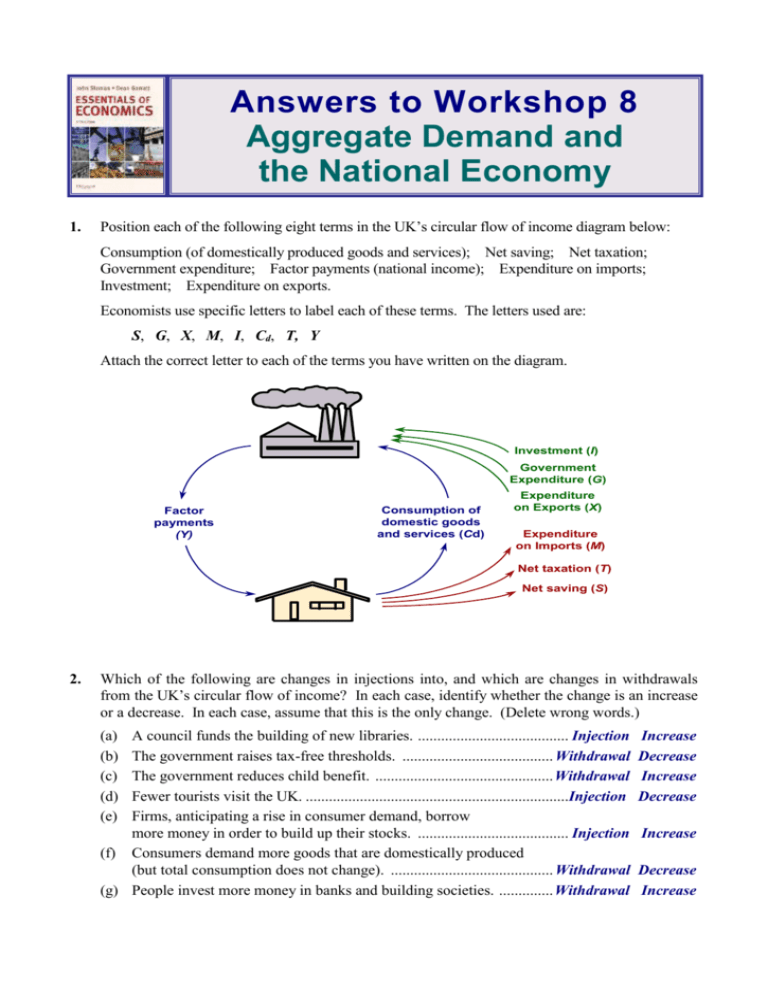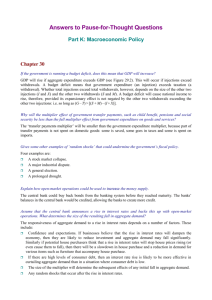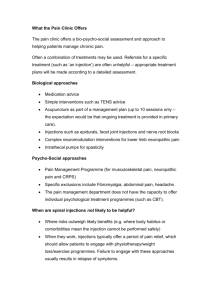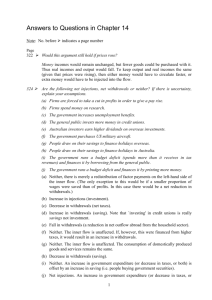Answers to Workshop 8
advertisement

Answers to Workshop 8 Aggregate Demand and the National Economy 1. Position each of the following eight terms in the UK’s circular flow of income diagram below: Consumption (of domestically produced goods and services); Net saving; Net taxation; Government expenditure; Factor payments (national income); Expenditure on imports; Investment; Expenditure on exports. Economists use specific letters to label each of these terms. The letters used are: S, G, X, M, I, Cd, T, Y Attach the correct letter to each of the terms you have written on the diagram. Investment (I) Government Expenditure (G) Factor payments (Y) Consumption of domestic goods and services (Cd) Expenditure on Exports (X) Expenditure on Imports (M) Net taxation (T) Net saving (S) 2. Which of the following are changes in injections into, and which are changes in withdrawals from the UK’s circular flow of income? In each case, identify whether the change is an increase or a decrease. In each case, assume that this is the only change. (Delete wrong words.) (a) (b) (c) (d) (e) A council funds the building of new libraries. ....................................... Injection The government raises tax-free thresholds. ....................................... Withdrawal The government reduces child benefit. .............................................. Withdrawal Fewer tourists visit the UK. ....................................................................Injection Firms, anticipating a rise in consumer demand, borrow more money in order to build up their stocks. ....................................... Injection (f) Consumers demand more goods that are domestically produced (but total consumption does not change). .......................................... Withdrawal (g) People invest more money in banks and building societies. .............. Withdrawal Increase Decrease Increase Decrease Increase Decrease Increase 3. What will happen to the level of the UK’s national income if the following changes occur? (In each case assume other things remain unchanged.) (a) Firms are encouraged by lower interest rates to build new factories. Rise (b) Consumers abroad are deterred by a high price for the pound from buying imports from the UK. Fall (c) Both taxation and government expenditure are reduced. Impossible to tell without more information You would need to know the respective sizes of the reduction in taxation (a reduction in withdrawals) and the reduction in government expenditure (a reduction in injections). (d) People decide to save a larger proportion of their income. Fall (e) Our trading partners abroad begin to recover from recession. Rise As they recover from recession, so consumer spending will increase. Part of the extra spending will go on UK exports (an injection into the UK's circular flow of income). 4. (a) Assuming that injections are constant at all levels of national income at £20 billion, complete the following table. Income (Y) (£bn) 40 80 120 160 200 240 280 Consumption (Cd) (£bn) 40 70 100 130 160 190 220 Injections (J) (£bn) 20 20 20 20 20 20 20 0 10 20 30 40 50 60 60 90 120 150 180 210 240 Withdrawals (W) (£bn) Aggregate expenditure (E) (£bn) (b) Calculate the marginal propensity to consume domestically produced goods (mpcd). Cd / Y = £30bn / £40bn = ¾ or 0.75 2 (c) On the diagram below, label the line shown and then plot Cd , J and aggregate expenditure (E) against national income (Y). See diagram Y Cd, J, W 280 (£bn) E2 E 240 Cd 200 160 120 80 W J2 40 J 0 0 40 80 120 160 200 240 280 National income (Y) (£bn) (d) What will be the equilibrium level of income (where E = Y)? £120bn (e) What are withdrawals and injections at this level of income? W …. £20bn J £20bn (f) Plot the withdrawals line on the diagram. See diagram. You should now be able to see that there are two ways of finding the equilibrium level of national income. Still referring to the table and diagram on the previous page, assume now that injections increase by £20 billion at all levels of national income. (g) Plot the new injections line on the diagram. See dashed J2 line on the diagram on previous page (h) Plot the new total expenditure (E) line on the diagram. (i) Mark the new equilibrium level of national income. (j) How much has national income increased? See dashed E2 line £200bn (where E2 = Y and J2 = W) £80bn (k) How many times bigger is the rise in national income than the rise in injections? 4 3 5. (a) If the multiplier is 5 and the government decides to increase its expenditure by £10m, by how much will national income increase before equilibrium is restored? .................................. £50m (b) Explain why an increase in injections will lead to a multiplied rise in national income. Because the increased injections will stimulate extra production and thus generate extra incomes. Some of the extra incomes will then be withdrawn by households (depending on the mpw) and some will be spent. This increased consumption then stimulates firms to produce yet more goods. In doing so, this will lead to extra incomes of that amount. Part of this will be withdrawn, but again, part will be spent thus further stimulating production and incomes. And so the process goes on until all the increase in injections has leaked away into the withdrawals flow. (c) The formula for the multiplier is 1 / (1–mpcd) or 1 / mpw (where the mpcd is the marginal propensity to consume domestic goods and services (Cd / Y) and the mpw is the marginal propensity to withdraw (W / Y). Referring back to question 5 above, what are the values of the mpw and the mpcd? mpw = .........................................10/40 = 0.25 mpcd = .................................... 30/40 = 0.75 (d) In question 4, what is the value of the multiplier?.......................................................................... 4 (e) Assuming now that the multiplier is 5 (as in part (a) of this question), what are the values of the mpw and the mpcd? mpw = ................................................................................................................................ 1/5 = 0.2 mpcd = ............................................................................................................................... 4/5 = 0.8 6. When calculating real GDP we must use the GDP deflator for that year. This allows us to adjust figures measured in current prices for the rate of inflation, and show them in terms of a base year. Assume that GDP in current prices grows from £120bn in year 1 to £160bn in year 2 and that the GDP deflator rises from 100 in year 1 to 130 in year 2, by how much has real GDP grown? 2.56% This is calculated as follows: Real GDP = Nominal GDP/GDP deflator 100. Thus in year 1, real GDP = £120bn/100 100 = £120bn and in year 2, real GDP = £160bn/130 100 = £123.07bn real GDP has grown by (123.07 – 120)/120 100 = 2.56% 7. What would be the effect of each of the following events on actual and potential economic growth? (Assume no other changes take place.) 4 (a) A reduction in the level of investment. Actual growth: fall Potential growth: fall (b) People save a larger proportion of their income. Actual growth: fall Potential growth: rise (c) Increased expenditure on education and training. Actual growth: rise Potential growth: rise (d) The discovery of new more efficient techniques which could benefit industry generally Actual growth: no effect Potential growth: rise (e) A reduction in interest rates. Actual growth: rise Potential growth: rise (because of higher investment and hence increased production capacity in the economy) 5 6










